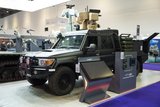LandWarNet 2011: LGS develops next-generation 4G solution
LGS Innovations is preparing to bring the next-generation variant of its Wimax 4G Readily Deployable Network (RDN) into service by the beginning of 2013 at the latest, company executives have revealed.
Speaking to Shephard at the LandWarNet conference in Tampa on 27 August, VP business development and sales Daniel Bigbie said the '4G Long Term Evolution' (LTE) would follow on from evaluation of the Wimax 4G variant at the US Army's Network Integration Evaluation (NIE) at Fort Bliss, New Mexico in October.
According to the company, the RDN comprises a range in excess of 10km and uses WiMax technology to provide wireless voice, video and data transmissions.
The RDN he said, could be set up in 10 minutes to provide voice, video and data capabilities for up to 80 different users operating smartphones. He added that LGS was working on an agreement with Motorola to use Android handsets for the NIE.
LGS employees have already been on site at Ft Bliss for a couple of weeks now ahead of the forthcoming NIE, Bigbie explained. 'This is a new technology for consideration for the NIE,' he urged.
'For an army deploying into a hostile territory, this capability has become very valuable for instant communications to augment what they already have,' Bigbie explained. 'The army has a set of problems to solve right now and they cannot wait until 2013 [for such technology].'
'Normally, an army will have SATCOM [satellite communications] capability but they do not get voice, video and data over a handheld [device] with larger radio systems. Wimax 4G satisfies size, weight and power requirements and flexibility on devices,' he continued. However, he warned that such a capability did not reduce the need for SATCOM.
More from Digital Battlespace
-
![Babcock nears first customer for Nomad AI translation tool]()
Babcock nears first customer for Nomad AI translation tool
Nomad can provide militaries with real-time intelligence, saving critical time on the battlefield.
-
![AUSA 2025: Israel’s Asio Technologies to supply hundreds of improved Taurus tactical systems]()
AUSA 2025: Israel’s Asio Technologies to supply hundreds of improved Taurus tactical systems
Taurus operates alongside the Israel Defense Forces’ Orion system which supports mission management across tens of thousands of manoeuvring forces, from squad leaders to battalion commanders.
-
![AUSA 2025: Kopin pushes micro-LED plans as China moves faster]()
AUSA 2025: Kopin pushes micro-LED plans as China moves faster
The plan for the new displays follows fresh investment in Kopin’s European facilities by Theon and an order for head-up displays in fielded aircraft, with funding from the US Department of Defense.
-
![AUSA 2025: Persistent Systems to complete its largest order by year’s end]()
AUSA 2025: Persistent Systems to complete its largest order by year’s end
Persistent Systems received its largest ever single order for its MPU5 devices and other systems earlier this month and has already delivered the 50 units to the US Army’s 4th Infantry Division.
-
![Aselsan brings in dozens of companies and systems under the Steel Dome umbrella]()
Aselsan brings in dozens of companies and systems under the Steel Dome umbrella
Turkey has joined the family of countries attempting to establish a multilayered air defence system with government approval in August 2024 for the effort landed by Aselsan. Dubbed Steel Dome, the programme joins Israel’s Iron Dome, the US Golden Dome, India’s Mission Sudarshan Chakra and South Korea’s low-altitude missile defence system.
-
![DSEI 2025: MARSS unveils new agnostic multidomain C4 system]()
DSEI 2025: MARSS unveils new agnostic multidomain C4 system
MARSS’ NiDAR system has been deployed using sensors from static platforms to provide detection and protection for static sights, such as critical infrastructure, ports and military bases.




























